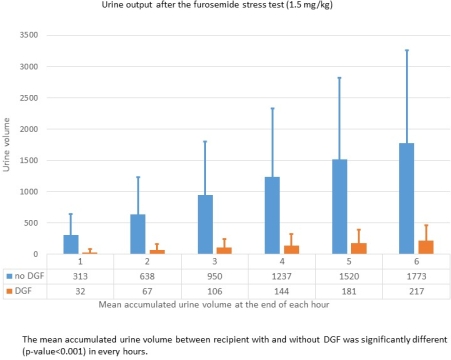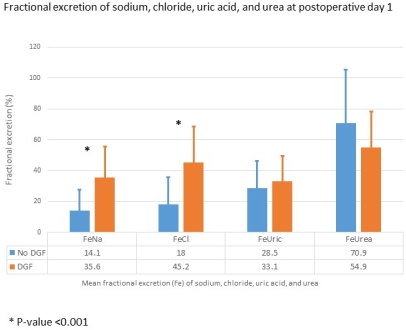Furosemide Stress Test as a Predicting Biomarker for Delayed Graft Function in Kidney Transplantation
1Nephrology, Chulalongkorn University and King Chulalongkorn Memorial Hospital, Bangkok, Thailand
2Pathology, Chulalongkorn University and King Chulalongkorn Memorial Hospital, Bangkok, Thailand.
Meeting: 2018 American Transplant Congress
Abstract number: D131
Keywords: Graft function, Kidney transplantation
Session Information
Session Name: Poster Session D: Kidney Donor Selection / Management Issues
Session Type: Poster Session
Date: Tuesday, June 5, 2018
Session Time: 6:00pm-7:00pm
 Presentation Time: 6:00pm-7:00pm
Presentation Time: 6:00pm-7:00pm
Location: Hall 4EF
Delayed graft function (DGF) is considered as a risk factor for long-term allograft failure and rejection episodes.There is currently no biomarker in the immediate post-kidney transplantation period that accurately predicts DGF.We conducted a prospective study of deceased donor kidney transplantation.All recipients received one dose of intravenous furosemide, 1.5 mg/kg at 3 hours after the allograft reperfusion. We aimed to evaluate the ability of urine output to predict DGF. Fifty patients were enrolled, and 22 patients developed DGF. Recipients with DGF had higher donor terminal creatinine (2.74±1.80 vs 1.50±0.73 mg/dL,p=0.009) compared with non-DGF recipients.The area under the receiver operating characteristic curves (AUC of the ROC curves) of the accumulated 4-hours urine volume after furosemide was the highest compared with other biomarkers (0.938±0.032,p<0.001). The best cut-off for predicting DGF was less than 150 mL with 77% sensitivity, 96% specificity, and 87% accuracy. Multivariate analysis by logistic regression showed hazard ratio of 0.993 (0.988-0.999, p=0.020) for 4 hours urine output as a protective factor against DGF. Interestingly, the fractional excretion of sodium (FeNa) and chloride (FeCl) at postoperative day 1 were significantly higher in patients with DGF (35.6±19.8% vs 14.1±13.4% for FeNa;p<0.001, and 45.2±23.5% vs 18.0±17.9% for FeCl;p<0.001).
Fifty patients were enrolled, and 22 patients developed DGF. Recipients with DGF had higher donor terminal creatinine (2.74±1.80 vs 1.50±0.73 mg/dL,p=0.009) compared with non-DGF recipients.The area under the receiver operating characteristic curves (AUC of the ROC curves) of the accumulated 4-hours urine volume after furosemide was the highest compared with other biomarkers (0.938±0.032,p<0.001). The best cut-off for predicting DGF was less than 150 mL with 77% sensitivity, 96% specificity, and 87% accuracy. Multivariate analysis by logistic regression showed hazard ratio of 0.993 (0.988-0.999, p=0.020) for 4 hours urine output as a protective factor against DGF. Interestingly, the fractional excretion of sodium (FeNa) and chloride (FeCl) at postoperative day 1 were significantly higher in patients with DGF (35.6±19.8% vs 14.1±13.4% for FeNa;p<0.001, and 45.2±23.5% vs 18.0±17.9% for FeCl;p<0.001). In conclusion,the cut-off point of the 4-hours urine volume of less than 150 mL after the intravenous furosemide 1.5 mg/kg at 3 hours after allograft reperfusion, was a good DGF predictor. ClinicalTrials.gov identifier: NCT03071536.
In conclusion,the cut-off point of the 4-hours urine volume of less than 150 mL after the intravenous furosemide 1.5 mg/kg at 3 hours after allograft reperfusion, was a good DGF predictor. ClinicalTrials.gov identifier: NCT03071536.
CITATION INFORMATION: Udomkarnjananun S., Townamchai N., Iampenkhae K., Avihingsanon Y., Eiam-Ong S., Praditpornsilpa K. Furosemide Stress Test as a Predicting Biomarker for Delayed Graft Function in Kidney Transplantation Am J Transplant. 2017;17 (suppl 3).
To cite this abstract in AMA style:
Udomkarnjananun S, Townamchai N, Iampenkhae K, Avihingsanon Y, Eiam-Ong S, Praditpornsilpa K. Furosemide Stress Test as a Predicting Biomarker for Delayed Graft Function in Kidney Transplantation [abstract]. https://atcmeetingabstracts.com/abstract/furosemide-stress-test-as-a-predicting-biomarker-for-delayed-graft-function-in-kidney-transplantation/. Accessed December 24, 2025.« Back to 2018 American Transplant Congress
